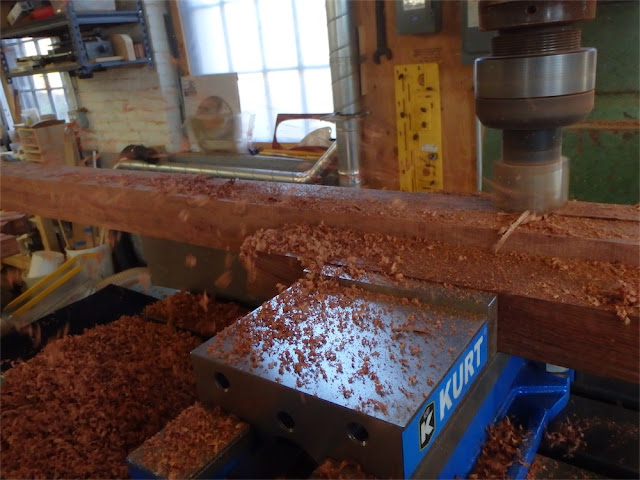This is the third project working with material from some big slabs of curly bubinga. Each time I delve back into this material I am brought face to face with one of the main challenges: the propensity of the wood to tear-out during processing.
Even with sharp knives, and four of them, in both jointer and planer, I have found I can only reliably dimension down to a certain point, beyond which I proceed at my peril. My shoebox Makita planer, given the high rpm, sharp knives and a shorter distance between the cutter head and the infeed/outfeed rollers, can obtain a slightly better finish, tighter to desired final dimension, than can the bigger planer, but I am still limited to dimensioning down to about 1/8" overside in a given dimension. Tear out, when it occurs, can pull fibers from nearly 1/16" into a surface, so if I want to be confident of obtaining a clean surface, I have to allow for that in the planing.
I’ve learned about this matter the hard way in the past, having to take some parts below intended dimension so as to produce a clean surface afterwards. I wanted to avoid that outcome this time around, and I have found that the tool that helps get me there is the FZ-5V milling machine with helical shell mill. Even longer pieces can be adequately supported and worked from each end to produce a flat surface:
Another view:
A close -up shows the fine slices that can be removed, a layer at a time until a clean surface is left, with one round or two of final planing or super-surfacing remaining:
Above is a skimming pass taken closer to the dimension, though at other times I will mill off 1/16" or more. Generally speaking, it’s not at all the type of milling, the heavier stock hogging, that one can undertake on the planer or the shaper. After all, we’re talking about a 4 hp spindle, not an 11 hp one.
With these particular sticks, their final form was to be an inverted ’T’ section, so in an effort to guard against unwarranted wood movement after the waste strips were ripped from the blanks to produce the ’T’, I left the stock oversize in every critical dimension prior to doing the rip cuts:
I’ll let the stock settle for a day or two before milling to final shape. The excess thickness in every dimension should allow me to realize the ideal stick hidden within - all being well also at dimension and straight and square. There is the ideal and then there is the reality. Just trying to shorten the gap between those two states.
Here are the short side pieces (top), with the pillow block stock (bottom) also being worked, step by step, down to the line:
It’s certainly not a quick process to mill the stock in this manner, as the amounts taken per pass are rather modest, but it has allowed me to obtain clean surfaces without tear out, getting closer and closer to dimension, and that is really all that matters to me.
All for today- thanks for visiting!
via Tumblr http://davidpires578.tumblr.com/post/133622391659





No comments:
Post a Comment